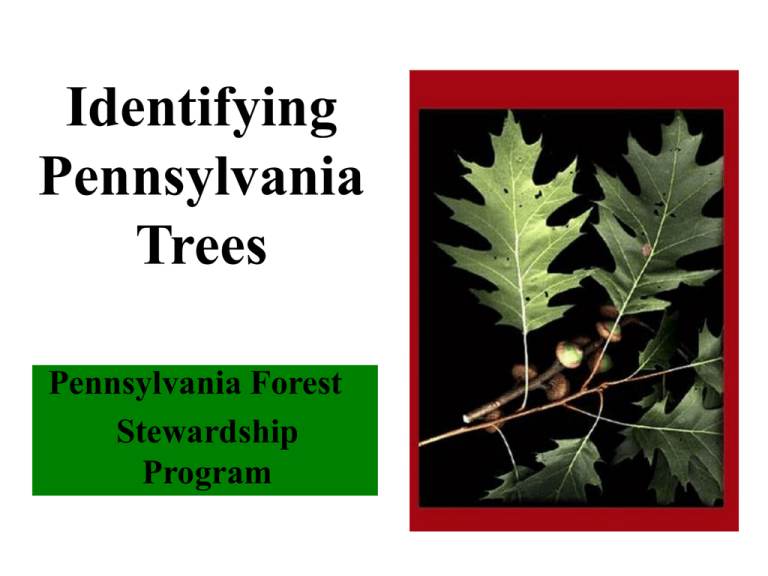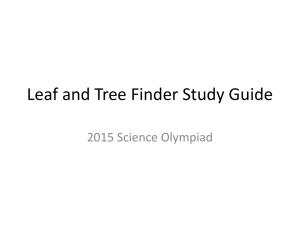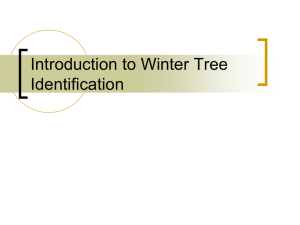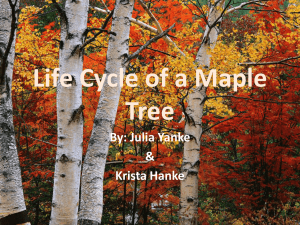Pennsylvania Tree I.D. Program
advertisement

Identifying Pennsylvania Trees Pennsylvania Forest Stewardship Program Tree Identification • In this presentation you will learn to identify trees using the Summer Key to Pennsylvania Trees. • Trees can be identified using many factors including leaves, bark, twigs, buds, flowers, and fruits. Leaf Types Scale-like Broad and flat Needles Leaf-type Comparison Leaf Arrangement Alternate Opposite Whorled Leaf Arrangement Comparison Leaf Structure A simple leaf Petiole (leaf stalk) Bud A Compound Leaf Leaflet Petiole (leaf stalk) Bud Pinnately compound A Compound Leaf Leaflet Petiole (leaf stalk) Bud Palmately compound Leaf Structure Comparison Leaf margins Serrate Dentate Double serrate Lobed Entire Identification Section Red Maple ID Slide Hint: opposite Red Maple Acer rubrum Red Maple Sugar Maple ID Slide Hint: opposite Sugar Maple Acer saccharum Sugar Maple Flowering Dogwood ID Slide Hint: opposite Flowering Dogwood Cornus florida Flowering Dogwood Northern Red Oak ID Slide Hint: alternate Northern Red Oak Quercus rubra Northern Red Oak White Oak ID Slide Hint: alternate White Oak Quercus alba White Oak White Oak versus Red Oak Comparison White Oak Red Oak American Beech ID Slide Hint: alternate American Beech Fagus grandifolia American Beech Yellow Birch ID Slide Hint: alternate / hairy Yellow Birch Betula alleghaniensis Yellow Birch Hint: alternate/hairy Sweet (Black) Birch ID Slide Sweet (Black) Birch Betula lenta Sweet (Black) Birch Paper Birch ID Slide Hint: alternate; hairy Paper Birch Betula papyrifera Paper Birch Eastern Hemlock ID Slide Eastern Hemlock Tsuga canadensis Eastern Hemlock Eastern Redcedar ID Slide Eastern Redcedar Juniperus virginiana Eastern Redcedar Balsam Fir ID Slide Hint: leaves do not have stalks Balsam Fir Abies balsamea Balsam Fir Norway Spruce ID Slide Norway Spruce Picea abies Norway Spruce Fir versus Spruce Balsam Fir Norway Spruce Eastern White Pine ID Slide (one bundle) Eastern White Pine Pinus strobus Eastern White Pine Horse Chestnut ID Slide Hint: opposite Horse Chestnut Aesculus hippocastanum Horse Chestnut Hint: needles more than 3 inches long Red Pine ID Slide Red Pine Pinus resinosa Red Pine American Elm ID Slide Hint: leaves rough American Elm Ulmus americana American Elm Bitternut Hickory ID Slide Clue: alternate, sap not milky Bitternut Hickory Carya cordiformis Bitternut Hickory Pitch Pine ID Slide Pitch Pine Pinus rigida Pitch Pine Black Cherry ID Slide Hint: leaf not compound and not hairy, margins have fine teeth; leaf stalks have glands. Black Cherry Prunus serotina Black Cherry Black Walnut ID Slide Hint: sap not milky; leaves hairy Black Walnut Juglans nigra Black Walnut American Larch ID Slide American Larch Larix laricina American Larch Wild Grape Not found in the key Wild Grape Vitis spp. Wild Grape White Ash ID Slide White Ash Fraxinus americana White Ash Sycamore Not found in the key Sycamore Platanus occidentalis Sycamore Sassafras ID Slide Sassafras Sassafras albidum Sassafras Cucumber-tree Magnolia ID Slide Hint: leaves usually greater than 5 inches long Cucumber-tree Magnolia Magnolia acuminata Cucumber-tree Magnolia Sweetgum ID Slide Sweetgum Liquidambar styraciflua Sweetgum Norway Maple ID Slide Norway Maple Acer platanoides Norway Maple Black Locust ID Slide Hint: sap not milky Black Locust Robinia pseudoacacia Black Locust Striped Maple ID Slide Striped Maple Acer pensylvanicum Striped Maple Smooth Sumac ID Slide Hint: milky sap Smooth Sumac Rhus glabra Smooth Sumac Yellow-poplar ID Slide Yellow-poplar Liriodendron tulipifera Yellow-poplar The Summer Key To Pennsylvania Trees is a small part of the Pennsylvania 4-H forestry curriculum. Contact your Penn State Cooperative Extension Office to request additional information about 4-H and other educational programs. •Prepared by Paul Roth, Research Assistant, and Rance Harmon, Extension Associate, The Pennsylvania State University, School of Forest Resources & Cooperative Extension Acknowledgements •Idea development and review: Jason Hall, Sandra Insalaco, and Cecile Stelter – Service Foresters – Pennslyvania Department of Conservation and Natural Resources, Bureau of Forestry •Review: James Finley & Sanford Smith, The Pennsylvania State University School of Forest Resources & Cooperative Extension •Images provided courtesy of Virginia Tech & The University of Wisconsin. •Line art courtesy of The Pennsylvania State University College of Agricultural Sciences and the Pennsylvania 4-H Program References •Common Trees of Pennsylvania, Department of Conservation & Natural Resources, Bureau of Forestry •The Audubon Society Field Guide to North American Trees Eastern Region, Knolph, Alfred A. Inc. 1980 •Virginia Tech Dendrological Web Page, www.fw.vt.edu/dendro/dendrology/main.html •University of Wisconsin, botanical images, www.wisc.edu/botit/dendrology/names.html Penn State is committed to affirmative action, equal opportunity, and the diversity of its workforce . © The Pennsylvania State University, 2002









